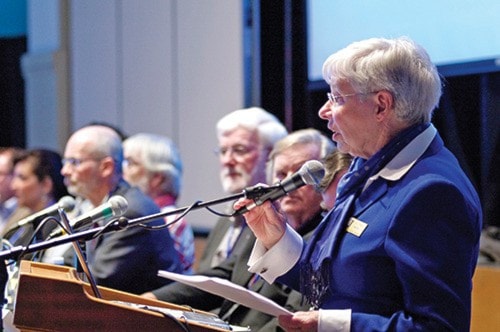Civil, with a chance of heckling, was the forecast for Tuesday night’s public information meeting on the proposed Malahat Liquefied Natural Gas (LNG) plant.
The event did not stray too far from that forecast, with the proponent — Steelhead LNG Project Director Alex Brigden — and the province’s LNG advocate Gordon Wilson taking the brunt of the heckling. As both spoke in favour of the project and the industry as a whole, they heard calls to “Leave it in the ground!”
For the most part, however, the proceedings were civil. Questions were limited to written submissions and there was a visible security presence both at the entrance to the Mary Winspear Centre and in the Bodine Hall.
Around 600 people came to hear about the project and information from its backers and opponents.
Most vocal in his opposition was Chief Don Tom of the Tsartlip First Nation. He reiterated the WSANEC nation’s stance from March, that all four First Nations communities on the Saanich Peninsula are opposed to the proposed LNG plant.
“We will not expose our community or yours to the risks that will come with this project,” he said to loud applause.
The plant would be located within the territory of the Malahat Nation, across the Saanich Inlet from the WSANEC nations, Sidney, Central Saanich and North Saanich. The latter District hosted the meeting as its council is trying to form a stance on the project.
Dr. Renee Racette, CEO of the Malahat Nation, said their community is still asking questions and noted the project is being debated well before it enters the environmental assessment process.
‘We have a stewardship responsibility that we take seriously,” she said.
Racette added that the Malahat Nation is also seeking ways to use its land and improve their economy to lift the community out of long standing poverty.
Brigden was unable to answer many of the questions posed by the audience directly, stating the project is still in the design stage. The plan is to build a floating loadout dock out in the Inlet with infrastructure on land, fed by a proposed pipleline from the U.S. Their LNG would be earmarked for the Asian market.
Issues such as carbon dioxide emissions, noise and the use of salt water cooling, he said, were not yet addressed. He was able to say, however, that tanker traffic — estimated to be one tanker in the Inlet every three to five days — could be controlled and prevent the need for moorage.
Dr. Robin Pitblado of DNV Energy North America, a specialist in marine risk assessment, said the LNG industry has a much better safety record than many other petrochemical industries. He explained while there are hazards associated the production, storage and transport of LNG, robust industry standards make the real risk of any of its main hazards (fire and explosions) low.
Saanich Gulf-Islands MLA Gary Holman was at the meeting and said he’s opposing the project solely on the basis of the stance taken by the WSANEC nations.
“As a party, the NDP supports resource development,” he said, “but it must be done responsibly and respect the wishes of First Nations.”
Holman’s office is surveying people’s general opinion on Malahat LNG on his webiste, garyholman.ca.
